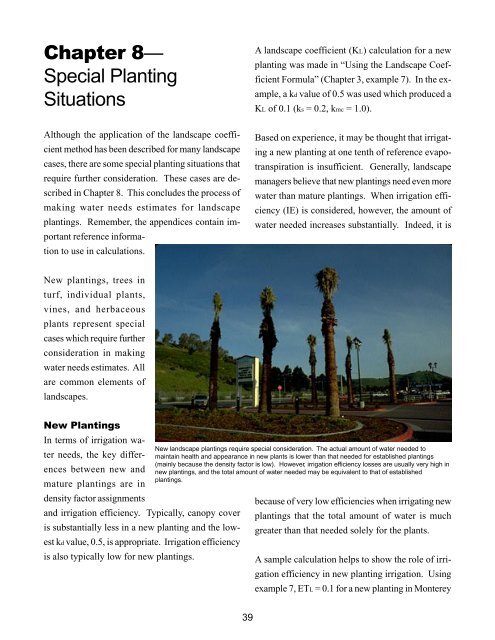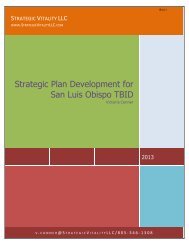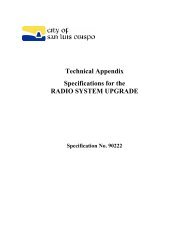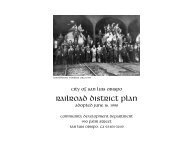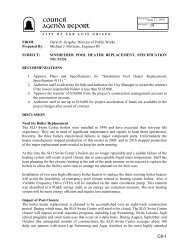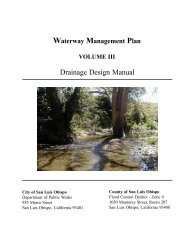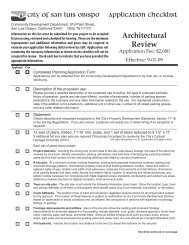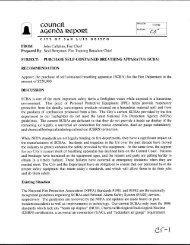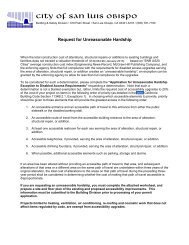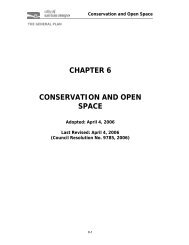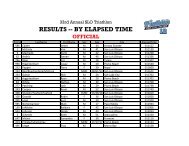Guide to Estimating Irrigation Water Needs of Landscape Plantings
Guide to Estimating Irrigation Water Needs of Landscape Plantings
Guide to Estimating Irrigation Water Needs of Landscape Plantings
You also want an ePaper? Increase the reach of your titles
YUMPU automatically turns print PDFs into web optimized ePapers that Google loves.
Chapter 8—<br />
Special Planting<br />
Situations<br />
A landscape coefficient (KL) calculation for a new<br />
planting was made in “Using the <strong>Landscape</strong> Coefficient<br />
Formula” (Chapter 3, example 7). In the example,<br />
a kd value <strong>of</strong> 0.5 was used which produced a<br />
KL <strong>of</strong> 0.1 (ks = 0.2, kmc = 1.0).<br />
Although the application <strong>of</strong> the landscape coefficient<br />
method has been described for many landscape<br />
cases, there are some special planting situations that<br />
require further consideration. These cases are described<br />
in Chapter 8. This concludes the process <strong>of</strong><br />
making water needs estimates for landscape<br />
plantings. Remember, the appendices contain important<br />
reference information<br />
<strong>to</strong> use in calculations.<br />
Based on experience, it may be thought that irrigating<br />
a new planting at one tenth <strong>of</strong> reference evapotranspiration<br />
is insufficient. Generally, landscape<br />
managers believe that new plantings need even more<br />
water than mature plantings. When irrigation efficiency<br />
(IE) is considered, however, the amount <strong>of</strong><br />
water needed increases substantially. Indeed, it is<br />
New plantings, trees in<br />
turf, individual plants,<br />
vines, and herbaceous<br />
plants represent special<br />
cases which require further<br />
consideration in making<br />
water needs estimates. All<br />
are common elements <strong>of</strong><br />
landscapes.<br />
New <strong>Plantings</strong><br />
In terms <strong>of</strong> irrigation water<br />
needs, the key differences<br />
between new and<br />
mature plantings are in<br />
density fac<strong>to</strong>r assignments<br />
and irrigation efficiency. Typically, canopy cover<br />
is substantially less in a new planting and the lowest<br />
kd value, 0.5, is appropriate. <strong>Irrigation</strong> efficiency<br />
is also typically low for new plantings.<br />
New landscape plantings require special consideration. The actual amount <strong>of</strong> water needed <strong>to</strong><br />
maintain health and appearance in new plants is lower than that needed for established plantings<br />
(mainly because the density fac<strong>to</strong>r is low). However, irrigation efficiency losses are usually very high in<br />
new plantings, and the <strong>to</strong>tal amount <strong>of</strong> water needed may be equivalent <strong>to</strong> that <strong>of</strong> established<br />
plantings.<br />
because <strong>of</strong> very low efficiencies when irrigating new<br />
plantings that the <strong>to</strong>tal amount <strong>of</strong> water is much<br />
greater than that needed solely for the plants.<br />
A sample calculation helps <strong>to</strong> show the role <strong>of</strong> irrigation<br />
efficiency in new planting irrigation. Using<br />
example 7, ETL = 0.1 for a new planting in Monterey<br />
39


